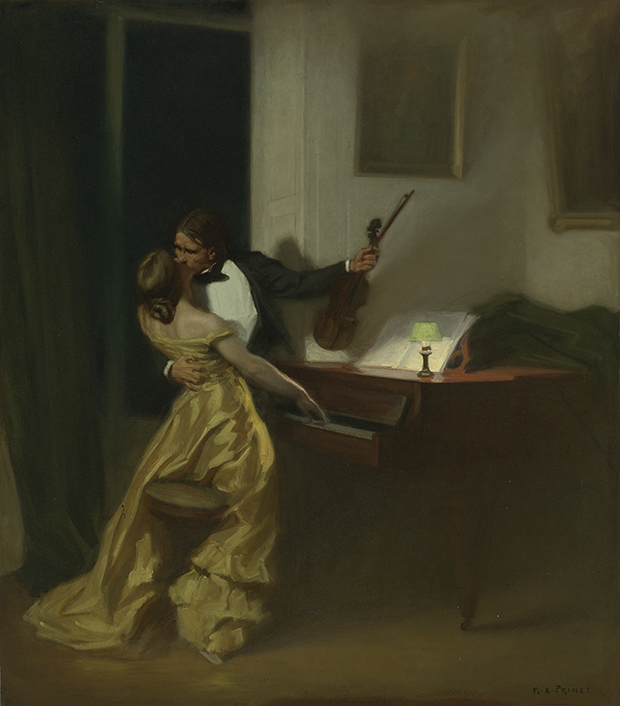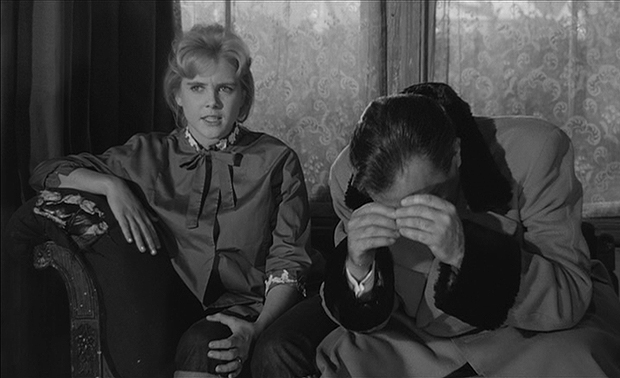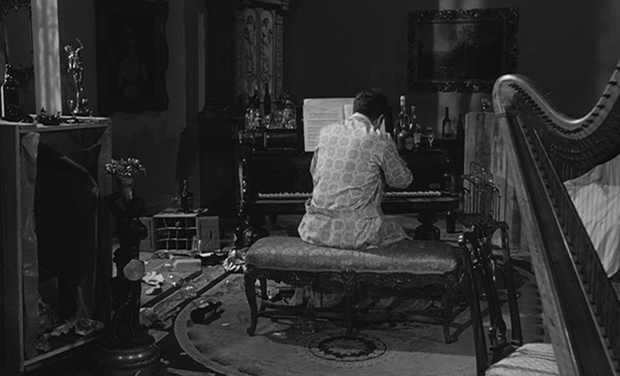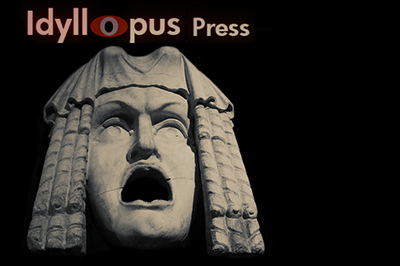The Kreutzer Sonata and Lolita
Go to Table of Contents of the analysis (which has also a statement on purpose and manner of analysis and a disclaimer as to caveat emptor and my knowing anything authoritatively, which I do not, but I do try to not know earnestly, with some discretion, and considerable thought).
When Kubrick married Christiane he acquired, as his uncle-in-law, the infamous Third Reich filmmaker Veit Harlan, the only film director of the Third Reich to be indicted for crimes against humanity due his infamous antisemitic propaganda movie Jud Süss. Made at the behest of Joseph Goebbels, Hitler's Minister of Propaganda, it was released in 1940, only a short five years after Harlan, an actor, had began directing films in 1935 when he was about 36 years of age. Harlan made a number of films in quick succession--Die Pompadour, Trouble Backstairs, Kater Lampe, Tired Theodore, All for Veronica, Maria die Magd, Madona in Warenhaus, The Kreutzer Sonata, Der Herrscher, My Son the Minister--all in 1935, through 1937, and in 1937 was tapped by Goebbels to be one of his leading propaganda directors. Between 1937 and 1940 he made, Jugend, Covered Tracks, The Immortal Heart, The Trip to Tilsit, and the infamous Jud Suss. Then from 1940 to the end of the war he made Pedro soll hängen, The Great King, The Golden City, Immensee - Ein deutsches Volkslied, The Great Sacrifice, and Kolberg. Twelve more films followed, between 1951 and 1965, after Harlan was acquitted, and there has since been the back-and-forth badminton as to whether Harlan really meant to do what he did, whether he really intended to make such an effective piece of antisemitic propaganda as Jud Suss, some individuals, including a few family members, mostly faulting him for simply being a great director who couldn't possibly make a bad film. He always had to do his best.
How great a filmmaker Harlan was is nearly impossible to assess as scarcely any of his films are available. Not to be flip, but it's difficult not to notice that the beginning of Harlan's filmography coincides with Hitler's seizure of power, the Night of the Long Knives occurring in 1934, and Hindenburg soon thereafter dying, Hitler becoming Fuhrer in accordance with the law, "Concerning the Highest State Office of the Reich", conveniently passed the day before Hindenburg's death, which abolished the office of president and merged presidential powers with those of the chancellor. There was a tremendous brain drain of creativity in Germany with artists fleeing, beginning about 1933. Another Hitler-approved director who came up at about the same time as Harlan was Leni Reifenstahl. Her Victory of the Faith was made in 1933, followed by Triumph of the Will in 1935, and Olympia in 1938.
"Kritallnacht" occurred in 1938, over 30,000 Jews arrested and sent to Dachau, which had been housing primarily political prisoners since 1933. Between 1939 and 1941 requirements were instituted that Jews must wear identifying badges. With the taking of Poland in 1939 began the rounding up of Jews into ghettos. In 1940 Dachau was converted to a concentration camp. In 1941 came the implementation of the "Final Solution" with mass killings of Jews, beginning at Chelmno with the first exterminations taking place in December of 1941. The first extermination of Jews at Auschwitz was also in 1941. Treblinka was opened in 1942, and Belzec, Sobibor, and Majdanek as well. I go into all this as, if we take a look at when Harlan's Jud Suss was made, it was just prior to the implementation of "The Final Solution", which in September and October of 1941 was in the planning stages of becoming a systematic reality. Jud Suss was first released in September of 1940 at the Venice Film Festival, then in Berlin in the same month.
Already curious about a similarity in composition of a battle scene in Barry Lyndon with Harlan's The Great King, realizing that Kubrick's uncle-in-law had also directed Kreutzer Sonata in 1937, I return to Nabokov's reference to the same sonata in Lolita and Kubrick's treatment of it, why he seems to have rejected including or even referencing the painting in his film, when he actually has not.
Beethoven wrote, in 1803, the "Kreutzer Sonata" for George Bridgetower, a mulatto virtuoso violinist whose father was likely from the West Indies, his mother a domestic worker for Sophie von Thurn and Taxis. At that time it was titled "Violin Sonata No. 9 in A major (Op.47)", however the two friends had a falling out, after which Beethoven rededicated the piece to another virtuoso, Rudolphe Kreutzer. Kreutzer never did play the piece publicly as he said it had already been performed and was too difficult, which may mean that he found it unwieldy.
Nabokov had in the Lolita novel the 1901 René François Xavier Prinet painting, "Kreutzer Sonata", hanging above the bed in the room that becomes Humbert's at the Haze's. The painting was once considered as scandalous, promoting immoral values, but Humbert's disdain for it, which echoes his repulsion for Charlotte, is due its being kitsch romantic art. In the painting, a female pianist, her hands still upon the piano's keys, has been swept up in a kiss by a male violinist. Because of the title, one assumes they are playing Beethoven's "Kreutzer Sonata", which served also as inspiration for Tolstoy's 1891 novella by the same name.

In Tolstoy's Kreutzer Sonata, the main character, Pozdnyshev, addresses the question of "what is love" when a woman insists marriages shouldn't be arranged but be based on true love. Pozdnyshev, in response, holds that love passes quickly, that women dress to arouse lust, and that there won't be sexual equality unless women are no longer subjects of desire and men no longer manipulated by carnality.
Pozdnyshev does marry and has little feeling for his wife other than as a sensual object, holding her as his possession. He is physically and emotionally abusive with her. A crisis arises when he imagines that she has embarked upon an affair with a violinist. His wife had recently taken up piano again, and, having no ear for music, furiously confused and frustrated by it, the husband observes the rapport between the two musicians and can only imagine it is sexual. When he arrives home early from a trip, he hopes to catch the pair together. The servant who greets him when he enters the house lets him know the violinist is there dining with the wife but appears himself to be undisturbed by this, as if it is totally innocent. The husband dismisses him, gets his weapons, and enters the dining room. His aspect is such that the violinist leaps away from the dining table, whereupon the husband pursues to attack him. The violinist crawling under the piano, the husband turns upon his wife, stabs her and then strangles her. Nothing had happened between the wife and violinist, it seemed. Only now, with his wife on the point of death, does the husband begin to see her as a person. She curses him and perishes. He is accused of murder but convinces the jury his wife was having an affair and is acquitted. The novella begins with his telling his story to others, anxious for them to comprehend his anxieties and forgive him.
Nabokov, in the Lolita screenplay, reiterated the need for the "Kreutzer Sonata" painting to be on the wall. He really wanted it there. Kubrick apparently did not for the painting doesn't appear in the film. Instead, on the wall immediately exterior Humbert's room is hung the painting of a woman or girl whose hands are in fists against her eyes, in the posture of one who is crying. At the end of the film. when Humbert, visiting Lolita, begins to cry, realizing he will not be able to convince her to leave her husband for him, he assumes the same posture as in the painting. Lolita tells him she is sorry for having cheated on him--though she was a child, and it is Humbert who should beg Lolita's forgiveness instead, which he never does.
Humbert's tears are prefigured in the painting that hung outside his bedroom/study at the Haze household.


It seems to me that though Kubrick doesn't have the Kreutzer painting in the film, he does refer to it and the sonata in the scene at the beginning in which Humbert confronts Quilty. After he takes a shot at him, Quilty tries to distract Humbert by playing a few erratic passages of music on the piano, then attempts to make a run for it. Humbert follows him, shooting as Quilty attempts to flee up the stairs to the second floor landing, where Quilty dies taking refuge behind a painting of a young woman. Humbert had been intent on murdering Quilty as he'd taken off with Lolita, and Humbert views him as a rival. In Tolstoy's book, the husband had attempted to first kill the piano player who hid under the piano, then instead had turned his rage on his wife and murder her. The portrait of the young woman through which Quilty is shot ties his own murder with Lolita, suggesting that Humbert has also mortally harmed her (actually we can also see Humbert as also a victim of himself).

I've not viewed the Harlan Kreutzer Sonata film, but from what I've read about it, when the wife, Jelaina, goes to Wiebaden on holiday with her son, she apparently have sort of an affair with her cousin, Gregor. During her absence, the husband visits nightclubs and consorts with prostitutes, but he holds himself to a different standard than his wife, and when Gregor kisses Jelaina at the resort, an already suspicious Posdnyshev is superimposed over the pair in close-up, as if he is aware of their actions from a distance. Though Gregor protests, Jelaina returns to Russia. Her husband shoots her, and is acquitted, but is a broken man. In the movie, Jelaina forgives him before she dies, whereas in the novel she curses him. If only we could view the movie we could examine why Harlan insists on Jelaina forgiving the man who kills her.
Leo Tolstoy's novella...was an ideal source for Harlan because its observations on music were identical with those he would explore in future films. The jealous husband, Posdnyshev, at one point, says, "And music in general is something horrible!...Music forces me, myself, to forget my own situation; it forces me into another, more friendly situation; under the influence of music it seems to me that I feel something I don't actually feel, as if I understand something I don't understand, as if I could achieve something I can't achieve...Music transforms me all of a sudden into that state of mind in which the poet of sound found himself. My soul is melting together with his, and together with him I wander from one state of mind into another; but why I am doing that, I don't know." Music, he complains, provides you with a tease, but you do not know what to do with that. Posdnyshev's wife and the other man who will win her heart are connected by music, "the most cunning, sensual means of luring and exciting."
From Veit Harlan: The Live and Work of a Nazi Filmmaker by Frank Noack
Tolstoy had led a highly sexual life when young, but later advocated complete sexual abstinence and the avoidance of carnal passions, practicing Christian self-perfection through asceticism. The book was intended to be an argument for sexual abstinence, so the views of the husband in the novel, whose passions lead him to feel out of control, to some degree reflect Tolstoy's own. A similar sense of being no longer in control of himself compels the protagonist's dislike of music, and though Tolstoy enjoyed music, and even composed, with his powerful response to music, and his assertion that with Beethoven, whom he admired, was the beginning of music's dissipation, it's easy to imagine how he would prefer to abstain from music that fostered extreme passions in his ascetic pursuit of self-control.
Tolstoy especially disliked Beethoven's 9th Symphony, which Kubrick uses to great effect in A Clockwork Orange, eventually revealed as a means by which Alex feels he hears the voice of god revealing how he should act.
“Beethoven's Ninth Symphony is considered a great work of art. To verify its claim to be such, I must first ask myself whether this work transmits the highest religious feeling? I reply in the negative, for music in itself cannot transmit those feelings; and therefore I ask myself next, Since this work does not belong to the highest kind of religious art, has it the other characteristic of the good art of our time,--the quality of uniting all men in one common feeling: does it rank as Christian universal art? And again I have no option but to reply in the negative; for not only do I not see how the feelings transmitted by this work could unite people not specially trained to submit themselves to its complex hypnotism, but I am unable to imagine to myself a crowd of normal people who could understand anything of this long, confused, and artificial production, except short snatches which are lost in a sea of what is incomprehensible. And therefore, whether I like it or not, I am compelled to conclude that this work belongs to the rank of bad art. It is curious to note in this connection, that attached to the end of this very symphony is a poem of Schiller's which (though somewhat obscurley) expresses this very thought, namely, that feeling (Schiller speaks only of the feeling of gladness) unites people and evokes love in them. But though this poem is sung at the end of the symphony, the music does not accord with the thought expressed in the verses; for the music is exclusive and does not unite all men, but unites only a few, dividing them off from the rest of mankind.”
"The Kingdom of God is Within You - What is Art:" by Leo Tolstoy
Considering how Kubrick heavily relies upon music in his films to communicate mood and sway the audience, everything Tolstoy's novel, which inspired the painting, represents as regards music may have been of interest to him, the violent aversion of Posdynshev to music as it caused him to he lose himself in blending with another's emotions, which was also expressed in Harlan's film, and I have wished I could view Harlan's film to see if there is any reference to it made in Lolita. As things stand, we do know that Kubrick did not include the physical painting, however much Nabokov wanted it, and instead had Quilty attempt to distract Humbert with the piano, and fail. In Nabokov's book, there is no banging out Chopin on the piano as Quilty faces death. Indeed, why does Quilty play Chopin? Is it because Chopin was Tolstoy's favorite composer?
A key word in Tolstoy's appraisal of Beethoven is "hypnotism", and I have more to remark on this in my post on Dusan Makavejev’s Man is Not a Bird and its relationship to A Clockwork Orange.
Approx 2031 words or about 4 single-spaced pages. A 15 minute read at 130 wpm.
Go to Table of Contents of the Lolita analysis
Link to the main Kubrick page for all the analyses

